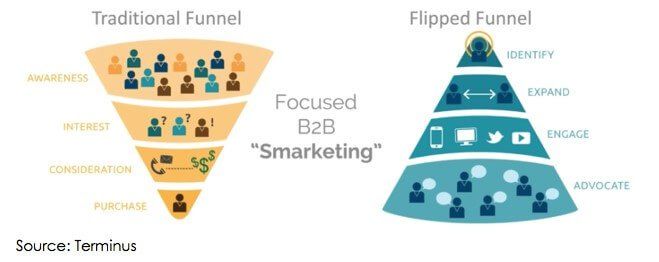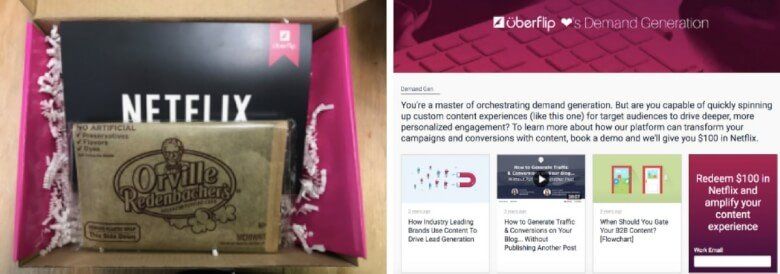
Account-based marketing (ABM) is an ideal way to build synergy between sales and marketing teams. It allows the teams to work together on the same accounts. Same goal, same priorities, same resource allocation. Based on ITSMA survey results, almost 85% of marketers measuring ROI say that ABM outperforms other marketing investments. However, there are unspoken challenges that you need to know before implementing ABM.
I had lunch with a good friend, Takashi Tokunaga, account-based marketing (ABM) manager at Intel. Previously, he led Intel’s Asia-Pacific region ABM efforts and was deeply entrenched with the country’s sales teams for one-to-one ABM. I asked him what ABM-centric marketing tactics are effective in Asia-Pacific. He laughed and said: “Events are still the most effective way to build one-to-one relationships, but the content is the key.” In India and Japan, for example, the sales and marketing teams continue to host customized and personalized account-specific events (for one account) or workshops at hotels.
Here’s how they do it
The marketing team would work with the sales team to create an invitation-only list. The marketing team also does extensive research on LinkedIn and other social media channels to identify potential prospects within the same account. In addition to managing event logistics, his team spent a significant amount of time gathering account-specific insights to craft a personalized agenda. He shared Intel’s product roadmaps, product demos, and megatrends, but he also invited 3rd party research firms such as IDC, Forrester, and ecosystem partners to be part of the event. He acknowledged that one-to-one ABM efforts take time and resources to get right and are challenging to scale.
Takashi’s sentiment is shared by many marketing managers who support ABM efforts. By talking to marketing managers who work closely with the field on ABM efforts, I identified some hidden challenges of implementing ABM that no one wants to talk about, but you need to know.
Three challenges that need to be addressed up front:
- Ability to change your own mindset and behaviors
- Lack of budget and resources and management buy-in
- Lack of know-how
Challenge 1: Ability to change your own mindset and behaviors
Although 81% of respondents indicated that they practice ABM, according to a 2017 State of Account-Based Marketing Survey, 76% of respondents indicated that the ownership of ABM resides either in field marketing or sales organizations. In a way, ABM is not widely adopted by the whole marketing group. Conventionally, most marketers still create marketing campaigns following the typical purchase funnel of awareness, consideration, and purchase:
- Build awareness of the brand.
- Educate people about the benefits.
- Entice people to consider.
- Facilitate the purchase decision.
If you implement ABM, it requires you, marketers, to think and behave differently by flipping that purchase funnel. Rather than starting a big marketing campaign to focus on a wide array of audiences, ABM starts with specific accounts, then, expands and engages with strategic and planned outreach as time goes.
With traditional marketing campaigns, marketers own the decisions of determining the target market. In ABM, the sales team is likely to tell marketers which accounts they should pursue as a team. In addition, marketing research becomes account-insight intelligence gathering. So yes, marketers still use the same outreach channels. The difference is in the way marketers approach the ABM effort.
Solutions to address the challenge:
- Embrace the flip channel approach.
- Be prepared to give up ownership of the target market.
- Gather account-specific insights, not just persona’s insights.
Challenge 2: Lack of budget and resources with management buy-in
It’s no surprise to any marketer that marketing budgets are always finite. When the budget is dispersed among all marketing functions, it’s challenging to get those functions to pool their budgets for a big initiative—unless pooling is driven and mandated from the top and supported with dedicated budget and resources. Implementing ABM is not free, it requires a process and platforms for sales and marketing to collaborate and strategies for sourcing content.
Solutions to address the challenge:
- Allocate budget and resources.
- Identify executive sponsors, preferably sales executives.
- Many ABM tools and platform are available in the market. Comprehend the collaboration process and needs, then source tools to support it. Google “ABM tools” and you’ll see a list of them. Do your research and request demos. Sourcing tools require research and experimentation. Here are some popular tools: LeadGenius, Demandbase, Engagio, Terminus, Uberflip and more.
Challenge 3: Lack of know-how
ABM requires new processes, new tools, and new incentives for sales and marketing to collaborate. In smaller companies, it may just require sales and marketing to work together closely. In big enterprises, a team may need to be trained, new skills (research on accounts, sourcing personalized content etc.) must be acquired, and new tools may need to be implemented.
Solutions to address the challenge:
- Conduct ABM-based training for team members.
- Launch marketing campaigns based on account-specific insights.
Personalization means tailored, customized, exclusive services and offerings. It requires time and effort to reach someone with a personal touch. In addition to Takashi’s example from Intel, here are several examples of ABM I thought were excellent.
Influitive’s Magic Quadrant ABM effort
I enjoyed this blog post, The Results Of 3 B2B Account-Based Marketing Campaigns: The Good, The Bad And The Ugly, from Influitive, an advocacy management platform, sharing their own ABM campaign efforts. It’s a fun read.
The marketing team decided to target accounts that were ranked in Gartner’s Magic Quadrant—but did not have as many customer reviews as would be typical for that type of firm.
They created custom videos that personally congratulated each company on the accounts’ standing in the Magic Quadrant and sent them via Twitter. Then, Influitive informed these accounts that they could get to the upper right (AKA the Holy Grail) of the quadrant with the help of their customers. With this approach, the sales team saw a high response rate, but it was very time-consuming to create the personal videos. Similar to Takashi’s comments, it’s also difficult to scale. However, they buckled down and did holiday video campaigns using similar tactics. The response rate was solid as well.
GumGum uses ABM to reach out to T-Mobile
GumGum’s CMO, Ben Plomion, shared their 3 Crazy ABM Campaigns that actually worked. One of the examples was about their efforts to land T-Mobile. Yes, it’s crazy, but it worked.
The marketing team noticed that T-Mobile CEO, John Legere, is active on Twitter and loves Batman. As T-Mobile was unrolling its unlimited data plan, they wanted T-Mobile to see how valuable GumGum’s computer vision technology could be and highlighted how the two of them could collaborate. Rather than going through the usual channels or sending a typical outbound email, the marketing team thought it would be smarter to go down a more personalized path. So they built a creative team of editors, writers, illustrators, and letterers who spent months making a comic book called T-Man and Gums.
When the comic book was completed, they shipped 100 copies to T-Mobile and its agencies of record. Within hours, Legere reached out on Twitter to praise the work. Hence, within a few days, a meeting was scheduled. The ABM tactic was definitely a risk, but it sparked a meaningful conversation that eventually led to T-Mobile becoming a client.
Uberflip’s customized Netflix package
Uberflip targeted and segmented accounts that have a similar profile, designing their campaign for segments that have the same tech, the same persona, and the same challenges. The marketing team creates a direct mail, ads, and content streams that speak to all of those accounts and then lightly customize that set of content for specific accounts. A great example is the Netflix box they sent out that was personalized but sent to a few accounts. Furthermore, this campaign involved direct mail, a digital experience, and personalized follow-up.
ABM is not free and there is no shortcut
ABM is a long play. For the reason it requires the team to be honest with each other to evaluate what works and what doesn’t. Depending on the scope of outreach, it also requires a massive amount of collaboration among sales, marketing, business units, and other functions.
ABM requires resources, time and a dose of creativity. Truman Tang from Influitive said it nicely: “The [ABM] campaigns had to be flashy enough that people would take notice, and personalized enough that they would feel special—but inexpensive enough to be doable.” The inexpensive part is debatable. However, I agree that it doesn’t need a big budget to do something nice for your target accounts.
So, embrace the changes, allocated budget and resources, get buy-in from management, learn the know-how, and let the FUN begin!





